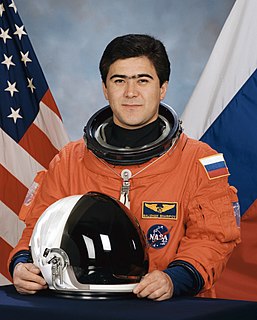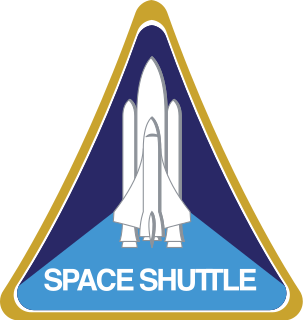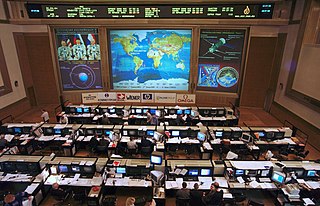Free drift mode refers to the state of motion of an object in orbit whereby constant attitude is not maintained. When attitude is lost, the object is said to be in free drift, thereby relying on its own inertia to avoid attitude drift.

In physics, an orbit is the gravitationally curved trajectory of an object, such as the trajectory of a planet around a star or a natural satellite around a planet. Normally, orbit refers to a regularly repeating trajectory, although it may also refer to a non-repeating trajectory. To a close approximation, planets and satellites follow elliptic orbits, with the central mass being orbited at a focal point of the ellipse, as described by Kepler's laws of planetary motion.
Inertia is the resistance, of any physical object, to any change in its velocity. This includes changes to the object's speed, or direction of motion.
This mode is often engaged purposefully as it can be useful when modifying, upgrading, or repairing an object in space, such as the International Space Station. [1] Additionally, it allows work on areas near the thrusters on the ISS that are generally used to maintain attitude. [2] While in free drift it is not possible to fully use the solar arrays on the ISS. This can cause a drop in power generation, requiring the conservation of energy. This may affect many systems that otherwise require a lot of energy. [3]

The International Space Station (ISS) is a space station, or a habitable artificial satellite, in low Earth orbit. Its first component was launched into orbit in 1998, with the first long-term residents arriving in November 2000. It has been inhabited continuously since that date. The last pressurised module was fitted in 2011, and an experimental inflatable space habitat was added in 2016. The station is expected to operate until 2030. Development and assembly of the station continues, with several new elements scheduled for launch in 2019. The ISS is the largest human-made body in low Earth orbit and can often be seen with the naked eye from Earth. The ISS consists of pressurised habitation modules, structural trusses, solar arrays, radiators, docking ports, experiment bays and robotic arms. ISS components have been launched by Russian Proton and Soyuz rockets and American Space Shuttles.
A thruster is a propulsive device used by spacecraft for station keeping, attitude control, in the reaction control system, or long-duration, low-thrust acceleration. A vernier engine or gimbal engine is a particular case used on launch vehicles where a secondary rocket or other high thrust device is used to control the attitude of the rocket while the primary thrust engine is fixed to the rocket and supplies the principal amount of thrust.
In physics and chemistry, the law of conservation of energy states that the total energy of an isolated system remains constant; it is said to be conserved over time. This law means that energy can neither be created nor destroyed; rather, it can only be transformed or transferred from one form to another. For instance, chemical energy is converted to kinetic energy when a stick of dynamite explodes. If one adds up all the forms of energy that were released in the explosion, such as the kinetic energy and potential energy of the pieces, as well as heat and sound, one will get the exact decrease of chemical energy in the combustion of the dynamite. Classically, conservation of energy was distinct from conservation of mass; however, special relativity showed that mass is related to energy and vice versa by E = mc2, and science now takes the view that mass–energy is conserved.
The amount of time that an object such as the ISS can remain safely in free-drift varies depending on moment of inertia, perturbation torques, tidal gradients, etc. The ISS itself generally can last about 45 minutes in this mode.

The moment of inertia, otherwise known as the angular mass or rotational inertia, of a rigid body is a quantity that determines the torque needed for a desired angular acceleration about a rotational axis; similar to how mass determines the force needed for a desired acceleration. It depends on the body's mass distribution and the axis chosen, with larger moments requiring more torque to change the body's rotation rate. It is an extensive (additive) property: for a point mass the moment of inertia is just the mass times the square of the perpendicular distance to the rotation axis. The moment of inertia of a rigid composite system is the sum of the moments of inertia of its component subsystems. Its simplest definition is the second moment of mass with respect to distance from an axis. For bodies constrained to rotate in a plane, only their moment of inertia about an axis perpendicular to the plane, a scalar value, matters. For bodies free to rotate in three dimensions, their moments can be described by a symmetric 3 × 3 matrix, with a set of mutually perpendicular principal axes for which this matrix is diagonal and torques around the axes act independently of each other.
















